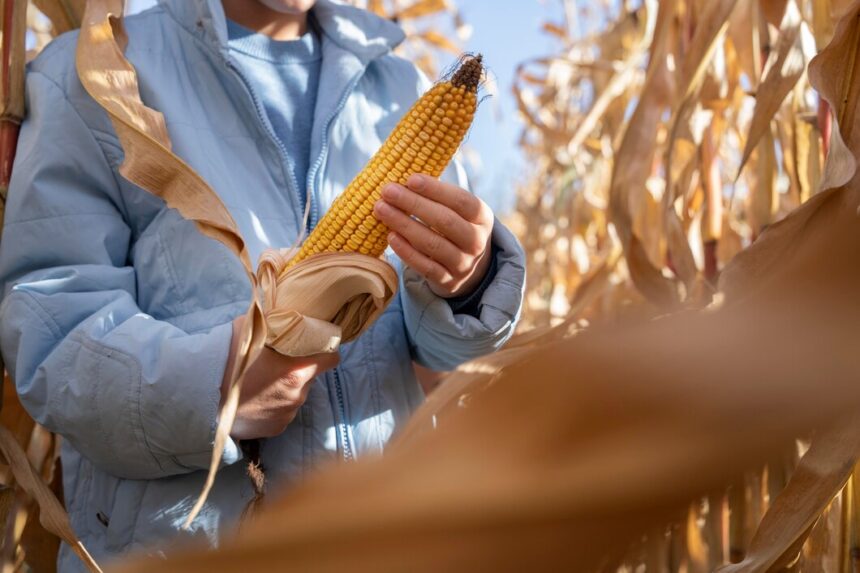Growing corn is a rewarding but intricate process that requires careful planning and management. Here’s a detailed guide covering each stage of corn production, including inputs, machinery, pests, and best practices for successful cultivation in South Africa.
1. Land Preparation
a. Soil Type and Preparation:
- Soil Type: Corn thrives in well-drained, loamy soils with a pH of 5.8 to 7.0. Avoid heavy clay or overly sandy soils.
- Preparation: Start with clearing the land of debris and previous crop residues. Plow or till the soil to a depth of 20-30 cm to break up compacted layers and improve soil aeration. Incorporate organic matter like compost to enhance soil fertility.
b. Machinery Required:
- Tractors: For plowing and tilling.
- Disk Harrows: For breaking up clods and smoothing the seedbed.
- Seeders/Planters: For accurate planting depth and spacing.
2. Planting
a. Timing and Depth:
- Timing: Plant corn after the last frost date when soil temperatures are consistently above 10°C.
- Depth: Plant seeds 5-7 cm deep. This depth ensures seeds are adequately covered for germination.
b. Inputs and Machinery:
- Seed: Use high-quality, certified seeds suited to your local climate and soil conditions.
- Planters: Use precision planters to ensure even spacing (usually 20-30 cm between plants and 75-90 cm between rows).
3. Fertilization
a. Types and Application:
- Types: Corn requires a balanced mix of nitrogen (N), phosphorus (P), and potassium (K). Use a pre-plant fertilizer with a typical ratio like 10-20-10.
- Application: Apply fertilizers based on soil tests. A side-dressing of nitrogen is recommended when the plants are about knee-high.
b. Machinery Required:
- Fertilizer Spreaders: For even application of granular fertilizers.
- Injection Systems: For applying liquid fertilizers.
4. Watering
a. Requirements and Frequency:
- Amount: Corn needs about 500-800 mm of water throughout the growing season, depending on rainfall and soil type.
- Frequency: Water every 7-10 days during dry periods. Ensure soil moisture is consistent, especially during the pollination phase.
b. Machinery Required:
- Irrigation Systems: Drip or sprinkler systems are ideal for maintaining moisture levels.
5. Growth Stages
a. Vegetative Stage:
- Key Tasks: Monitor for proper leaf development and manage weed competition.
- Inputs: Ensure proper fertilization and irrigation.
b. Flowering and Pollination:
- Key Tasks: Ensure good pollination by maintaining optimal plant spacing and avoiding stress conditions.
- Monitoring: Check for signs of poor pollination like incomplete kernel formation.
c. Maturity:
- Indicators: Corn is ready for harvest when the kernels are dented and the husks are dry. The moisture content should be around 20-25%.
6. Harvesting
a. Timing and Methods:
- Timing: Harvest when kernels are at 15-20% moisture. This can vary depending on the corn variety and climate conditions.
- Methods: Use a combine harvester to cut and shell the corn.
b. Machinery Required:
- Combine Harvesters: For efficient harvesting and shelling.
7. Storage
a. Preparation and Conditions:
- Preparation: Clean harvested corn to remove debris and damaged kernels.
- Conditions: Store corn in a dry, well-ventilated area to prevent mold and insect infestations. Ensure moisture levels are below 14% to prevent spoilage.
b. Machinery Required:
- Grain Bins: For bulk storage.
- Fans: To maintain airflow and control moisture levels.
8. Pests and Diseases
a. Common Issues:
- Pests: Watch out for maize weevils, corn earworms, and aphids. Use insecticides as needed.
- Diseases: Look for signs of rust, blight, and corn smut. Fungal infections can be managed with fungicides and proper crop rotation.
b. When to Use Pesticides and Herbicides:
- Pesticides: Apply when pest thresholds are reached, typically indicated by visible damage or pest counts.
- Herbicides: Use pre-emergence and post-emergence herbicides to control weeds. Apply according to the specific weed species and growth stage.
Successful corn farming in South Africa involves careful attention to each stage of growth, from land preparation to harvesting and storage. By implementing these practices and utilizing the right machinery and inputs, farmers can achieve optimal yields and maintain high-quality corn production. Regular monitoring and adaptive management are key to overcoming challenges and maximizing productivity.
Join 'Farmers Mag' WhatsApp Channel
Get the latest Farming news and tips delivered straight to your WhatsApp
CLICK HERE TO JOIN






